What Is a Flange? - From Types to Machining
 Jul 01,2025
Jul 01,2025

Flange is a crucial component in engineering and industrial applications as it is utilized in connecting pipes, pumps, valves etc. Flanges offer durable and efficient methods to join the parts together. They provide a leak-proof, secure connection that makes inspection, maintenance and modification of the machine easy. facilitating maintenance, repairs, and modifications without resorting to welding. More information about flange types, materials and applications are discussed in this article.
What is a Flange?
Flange is a component that protrudes from a body, like pipes, beams, or wheel. It is external as well as internal ridge, lip, or rim. These are designed to stabilize the structure and increase strength for movement of part. Flange connects by bolting, and sealing is done by using gaskets or other methods.
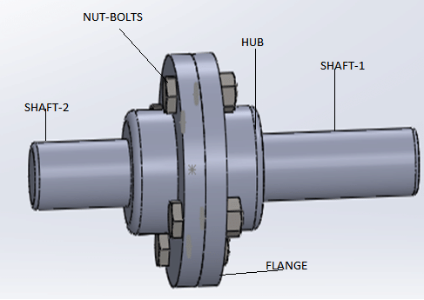
What Is the Purpose of a Flange?
Flanges can have many purposes like these can connect various parts in piping systems, provide strength for a reliable connection, make easy access for inspection and align pipe to minimize stress. In construction, flanges offer strength and stiffness to structure by increasing the area of contact and load distribution. They make beams and columns more resistant to buckling and deformation. There are different types of flanges in piping.
How Does a Flange Work?
Mechanical flanges have gaskets and bolt-ups to connect the piping systems. Flange face is the surface that the gasket seals against. Flange faces can either be flat or raised, depending on the required pressure and temperature. The gasket is located between the flange faces and a bolt compress to seal it tight. It is normally made of steel, cast iron, or stainless steel, depending on the requirements and applications of flange.
Load Transfer, Sealing, and Alignment
All the load and stress in the flange is disturbed on the connected equipment to prevent mechanical failure. A tight seal is created between connected parts by flange to prevent leakage. They also provide an accurate alignment to connected pipes for smooth flow and to minimize stress on the connection.
10 Common Flange Types and Face Types
Selection of specific flange type and face type depends on the requirements of pressure, temperature, fluid and other factors. There are different types of flanges in piping like Weld Neck, Slip-on, Socket Weld, Lap Joint, Threaded, and Blind flanges. These are differentiated on the connection technique like welding or threading. Details of these flange types are discussed below:
1.Weld Neck Flange
This type of flange has a circular fitting with a protruding rim around the circumference. Weld neck flanges with Raised Face (RF) and Ring-Type Joint (RTJ) face types are common in connecting parts. RF flanges have soft or semi-metallic gaskets. RTJ flanges have metal gaskets and are ideal for higher pressures and temperature.
2.Slip-On Flange
It has a flat face on the sealing surface and is suitable for low-pressure applications. Slip-on flanges with Flat Face (FF) have a flat sealing surface and RF flanges have a raised area to direct the gasket compression.
3.Blind Flange
It is a solid, disk-shaped flange that completely closes off the end of a pipe. Blind flanges connect permanently the end of a pipe, valve, or fitting with RF, FF, and RTJ. All these facet types have a unique seal design, suitable for different applications.
4.Threaded Flange
This type of flange has screw threads to connect the pipe. Threaded flanges with RF and FF are common face types and these types determine the sealing shape where the gasket sits.
5.Socket Weld Flange
This type of flange is useful on smaller sized high-pressure pipes. The common face types in Socket Weld Flanges are RF and FF. RF flange has a raised surface above the bolt circle for gasket seating for high pressure systems. And FF is used with full-faced gaskets in lower pressure systems.
6.Lap Joint Flange
This type of flange has a two-part assembly having a stub end with a lap-joint ring flange positioned on the top of it. Lap Joint Flange typically has FF type that is normally utilized in lower-pressure applications in non-metallic gaskets. FF does not really create seals. Sealing surface is on the stub end, connected with the flange.
7.Long Weld Neck Flange
This type of flange has a long neck, designed for high-pressure and temperature applications. They have longer neck than the standard weld neck flanges and allow a stronger and robust pipe connection. Long weld neck is normally having RF and RTJ face types.
8.Orifice Flange
This type of flange is used for measuring fluid flow. They have commonly RF or a RTJ face type. RF flanges have a raised surface to engage a gasket for sealing. And RTJ has a ring-shaped groove to create a tight connection.
9.Spectacle Blind Flange
This type of flange is used to temporarily block or isolate a pipeline for maintenance or inspection. It is normally a plate with one blind end and the other end is spectacle, connected by web. Spectacle blind flanges have RF and RTJ face types which are used to seal the flange with the adjacent flange.
10.Reducing Flange
This type of flange has two different bore sizes on the flange. This flange connects two pipes of different sizes. They are normally used to connect smaller pipes with larger ones. Reducing flanges comes in RF and FF face types.

Custom Flange Types
Custom flanges are specialized versions of various types of flanges. These are special flanges, designed to meet specific demands that are not entertained by normal designs. For example:
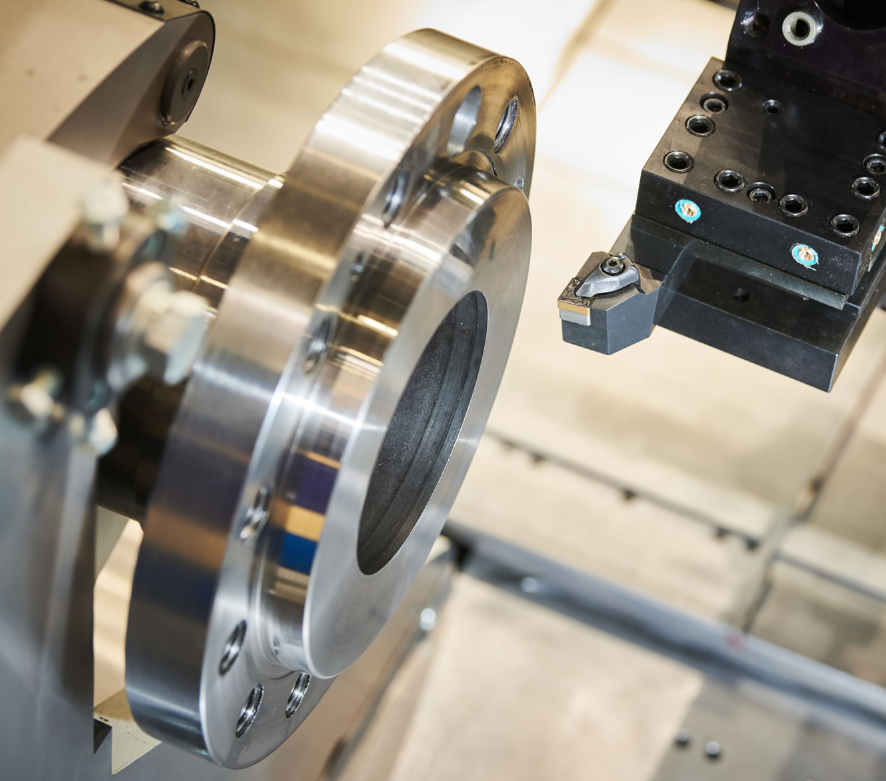
- Swivel Ring Flange
- Expander Flange
- Anchor Flange
- Nipoflange / Weldoflange
- Integral Flange
- Reducing Threaded Flange
- Orifice Union Flange
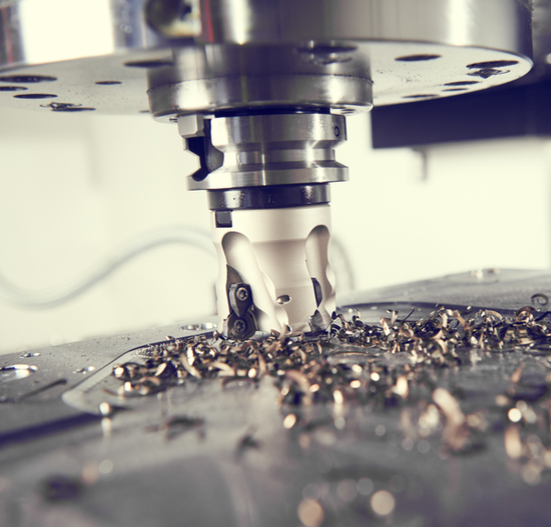
These various types of flanges can be altered in shape, face types, pressure rating, material type and other features that are suitable for unique applications.
Flange Facing Types Design for Different Gaskets
Flange parts have different types, designed to work with specific gasket types for better sealing. Common flange parts are as:
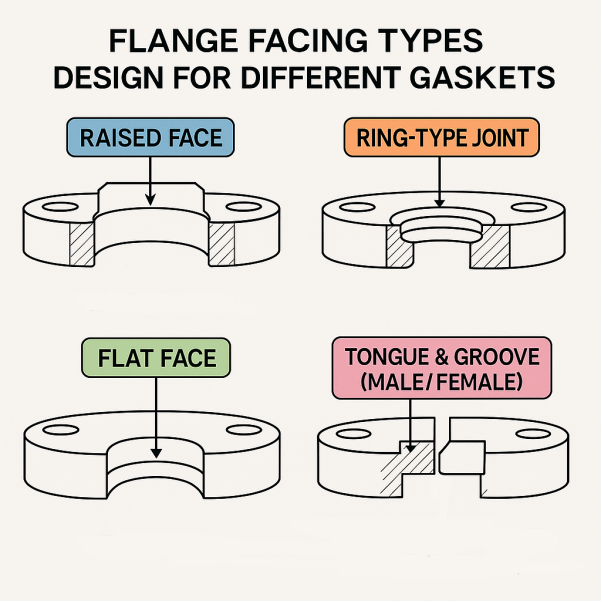
Raised Face (RF)
A RF flange has a raised, circular-shaped sealing face. It projects beyond the flange's bolt circle. In general, it uses spiral wound gaskets or soft gasket type. The RF offers a dedicated area for the gasket to seal.
Ring-Type Joint (RTJ)
The face type has a circular groove machined on the flange face. It uses oval or octagonal ring gaskets which are compressed within the groove to form a tight seal. It is normally used for high-pressure and high-temperature applications.
Flat Face (FF)
This face type has a flat machined surface. The flat face flange has full-faced non-metallic gaskets. The entire surface of FF flange provides the sealing area. It is normally used in low-pressure applications.
Tongue & Groove / Male & Female
This type of flange has a raised tongue, and the mating flange has a corresponding groove or recess. They use a gasket designed to fit the groove-tongue/male-female configuration.
How to Select Materials Before Machining?
Material selection of flange for machining depends on many factors like strength, cost, corrosion resistance alloy type. The most common factors are discussed below for material selection of flanges.
Carbon vs Stainless vs Alloy Steels Flange Types
Carbon steel mechanical flanges are low cost and have high strength and good machinability. But these are prone to corrosion. Stainless steel flanges have excellent corrosion resistance, strength and weldability. However, these are more expensive and difficult to machine than carbon steel. Alloy steel flanges have higher strength and corrosion resistance compared to carbon steel but require specific heat treatments for optimal properties.
High-Temp Nickel Alloys
Nickel alloy flanges have remarkable strength and corrosion and high temperature resistances. But these are very expensive and sometime difficult to machine. These are normally used in high-temperature machinery and aerospace applications.
Corrosion-Resistant Cladding Options
Corrosion resistant cladding in flanges offers protection for base metal from corrosion without compromising the structural integrity. However, they can increase the overall cost and complexity of the component. These are mostly used in chemical plants and pipelines.
CNC Machining Operations for Precise Flange Geometry
CNC machining provides precise control on complex flange geometries. Common Machining operations for flange geometry are as:
Face and OD Turning
Face and OD turning are carried on lathe machines. Material is removed from outer diameter (OD) and faces of the flange are machined to achieve the desired shape and size like cylindrical.
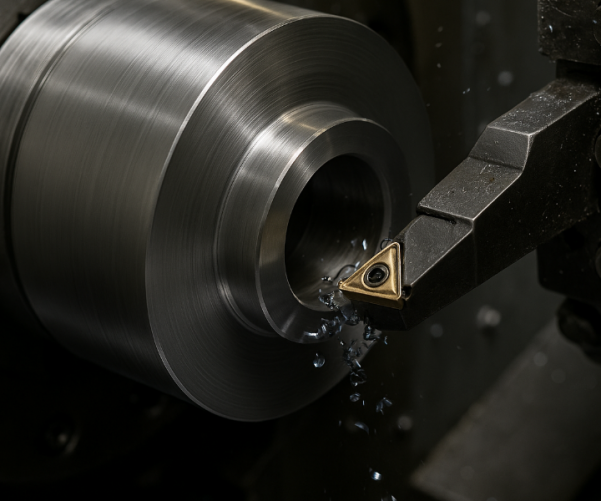
Boring the Hub & Bore
Boring machine is used to precisely enlarge and finish the inner diameter (bore) of the flange. It offers concentricity and a smooth finish of flange.
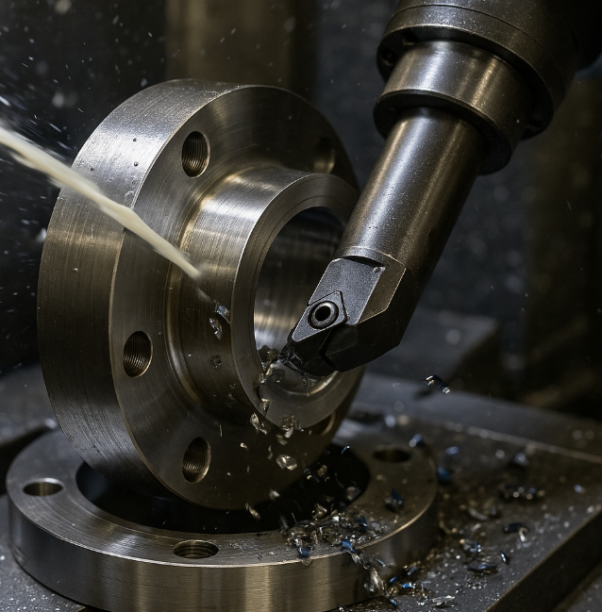
Drilling & Digitally Indexed Bolt Holes
Bolt holes are drilled precisely around the flange. They often use specialized drilling jigs for accurate placement and indexing of bolt holes. For digitally indexed bolt holes, CAD/CAM software is used to digitally index the bolt hole location. It offers accurate placement and repeatability. Then this digital index data is used to program the CNC machine to drill the bolt holes.
Pre-Machining Processes
In general, pre-machining processes like forging are carried out to shape the flange into the desired rough shape before machining. It potentially improves the material strength and grain structure. Heat treatment like hardening before machining, further improves the material's properties like hardness and toughness.
Inspection & Quality Control
Coordinate measuring machines are used to inspect the required tolerances and specifications machined flange. Visual inspection is also carried out to inspect the surface defects and overall quality.
Post-Machining Surface Treatments
Post-treatments like anodizing and powder coating are carried out to improve the surface finish of the flange. Anodizing is an electrochemical process used to create protective anodic oxide layer on flanges. Powder coating offers a durable and aesthetically pleasing finish. It also increases corrosion protection and impact resistance. Other surface treatments like painting, plating, or passivation are also done to increase durability and appearance of flanges.
What Is Tolerance and Surface-Finish of Flanges?
Critical tolerances for seating surfaces allow proper gasket seating and sealing. Hole positions and surface roughness are also important in sealing performance.
Flatness and Parallelism of Seating Face
Flat face flanges should be within the specific flatness range. It then allows the gasket to seal the surface. Seating face should be parallel to the bolt circle face to allow even pressure distribution.
Bolt-Hole True Position
Bolt holes must be placed precisely within a tolerance zone for proper bolt alignment and tension. The hole position is referenced to datums like flange face and edges to maintain accuracy.
Roughness (Ra) for Raised Face and RTJ Grooves
RF flange finishes normally from 3.2 to 6.3μm to allow a suitable gasket seal. Grooves in RTJ flanges also require a specific surface roughness for proper gasket seating and sealing performance. Ra defines as an arithmetic mean of the absolute value of the surface height deviation from the mean line. It is used to quantify surface roughness.
Conclusion
A flange is a bulging ridge or rim used to connect pipes and other components. Flanges provide strength for a reliable connection, make easy access for inspection and align pipe to minimize stress. These are often made of metal and can have a flat or raised face. They use bolt holes for fastening and gaskets to seal the pipes. Flanges are produced from machining processes such as cutting, milling, and drilling. Common types of flanges are weld neck, slip-on, socket weld, lap joint and blind flanges.
FAQs—From Sourcing to Machining
What tolerance is typical for RTJ groove depth?
According to the ASME B16.5 standard, RTJ (Ring Type Joint) groove depth has tolerance value of +0.4 mm, -0.0 mm.
How do I avoid tool chatter on large-diameter faces?
If you want to avoid tool chatter on large-diameter faces, prioritize rigidity in tools, adjust the cutting parameters with the workpiece's natural frequencies and use cutting fluids.
When should I specify duplex rather than 316L stainless?
Specify Duplex when high corrosion resistance and strength are required like in marine environments, and high-temperature conditions. 316L are used where high stress corrosion cracking resistance is required.
 Tel/WeChat:
Tel/WeChat:  Email:
Email: 
 Home
Home
 Types of Reverse Engineering and CNC Machining: Complete Guide
Types of Reverse Engineering and CNC Machining: Complete Guide 







